
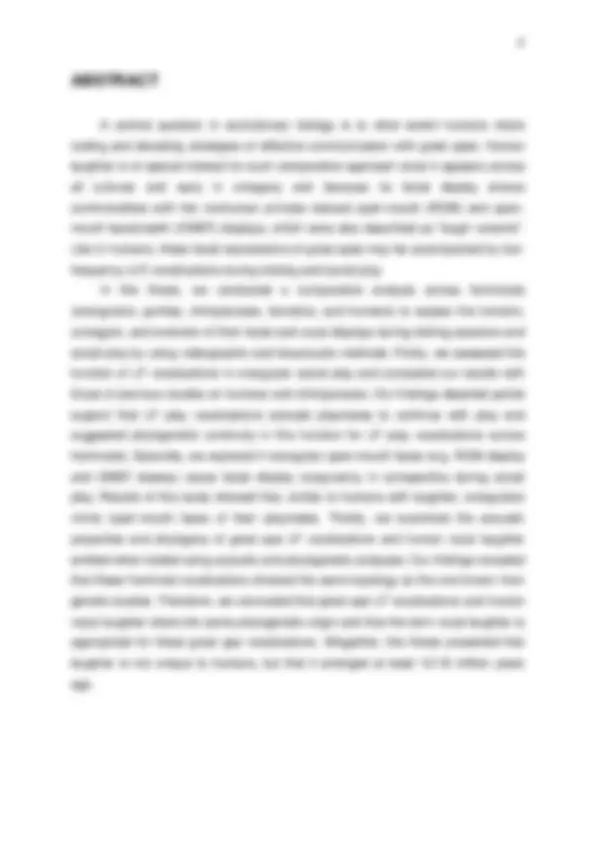
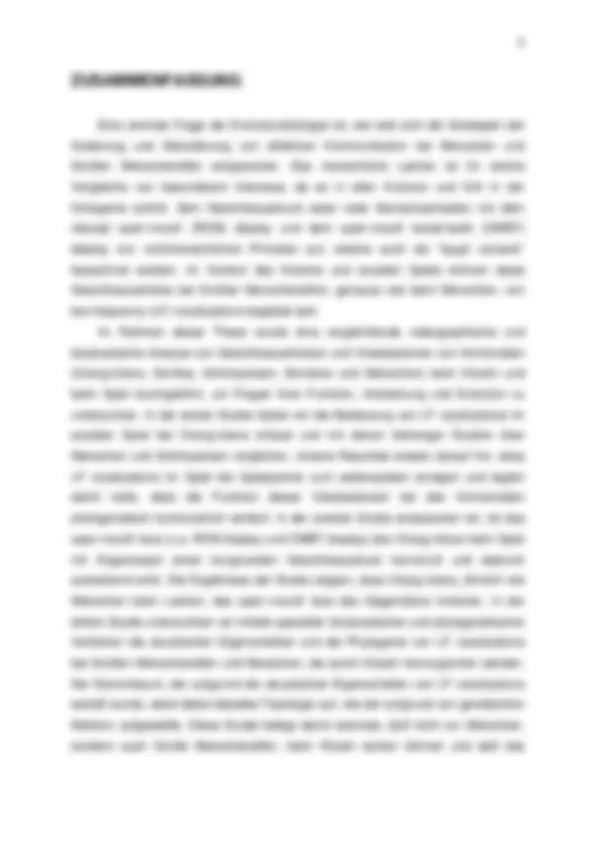



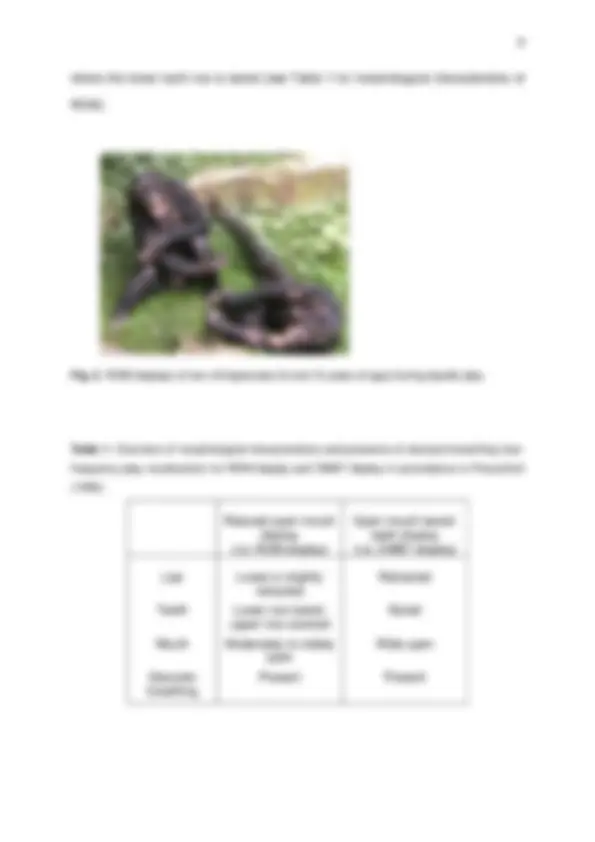
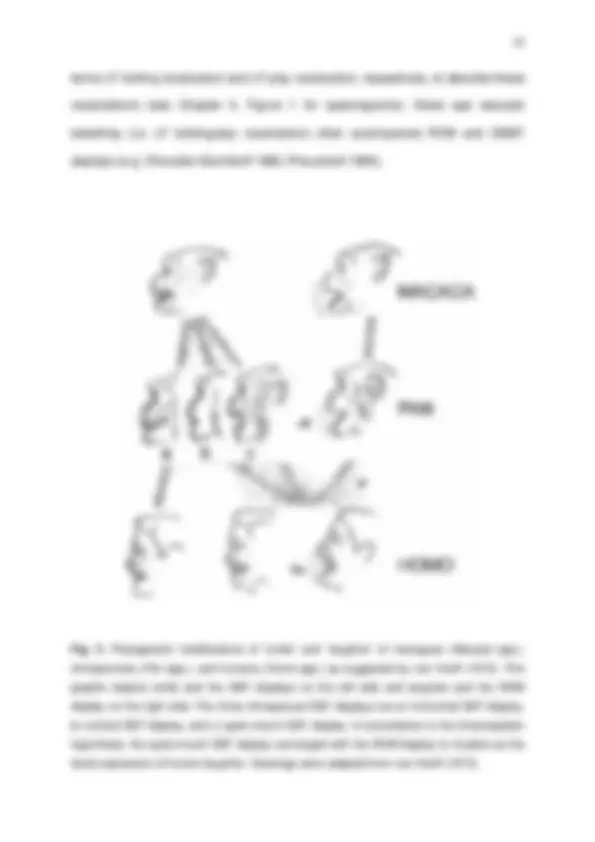
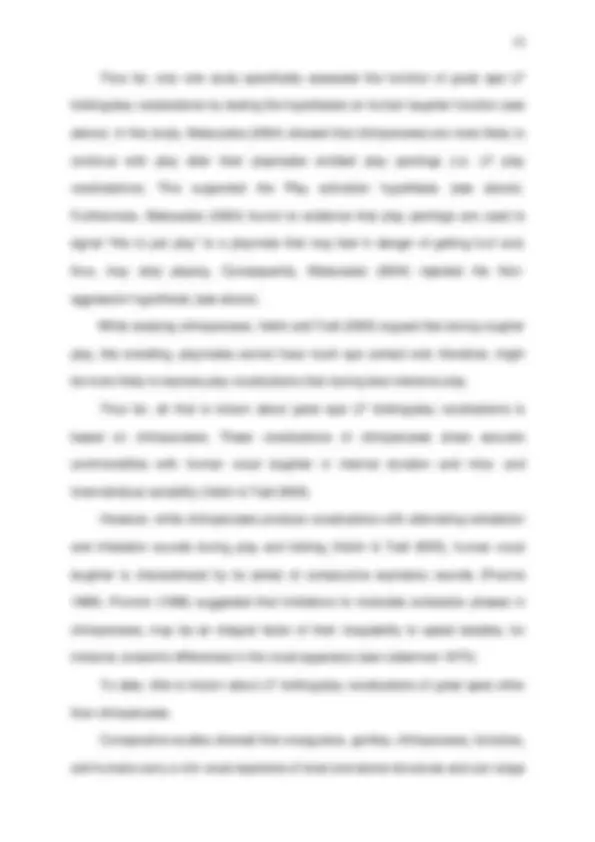
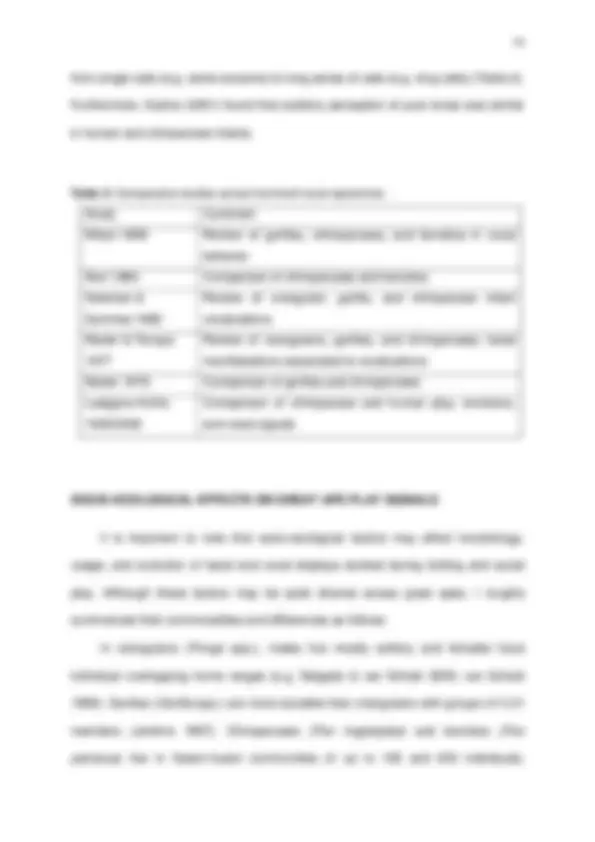
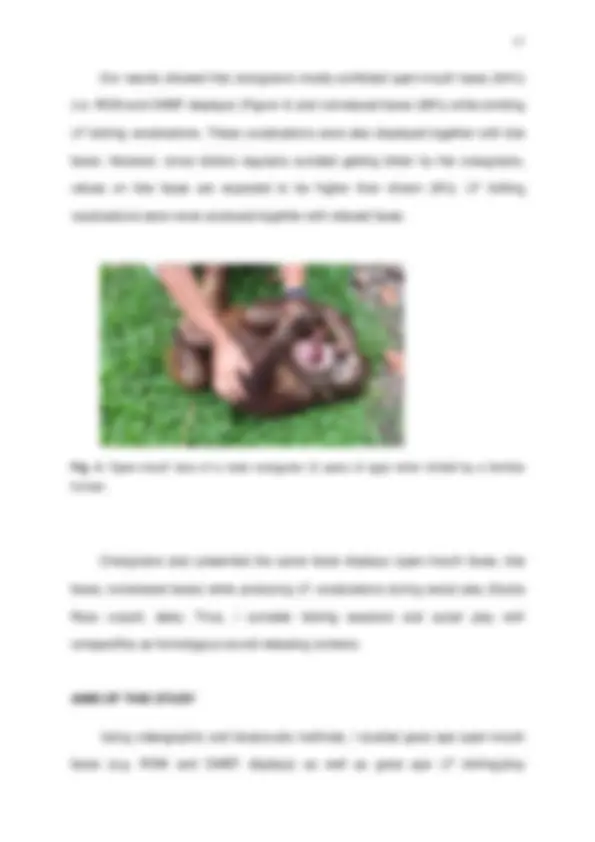
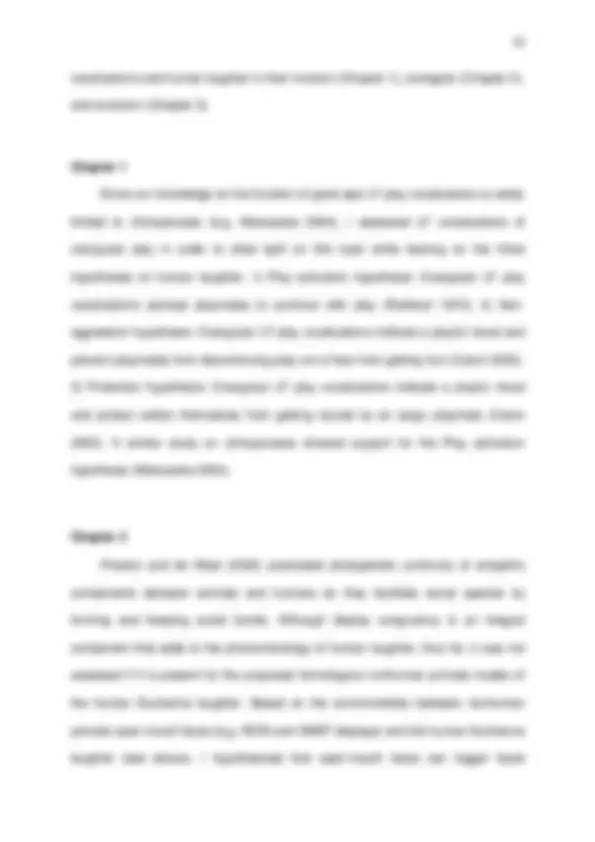
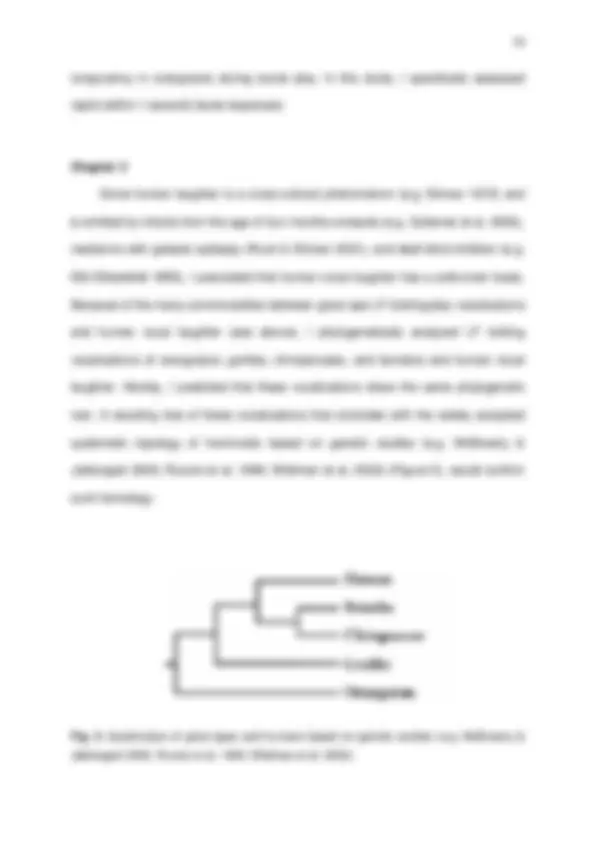
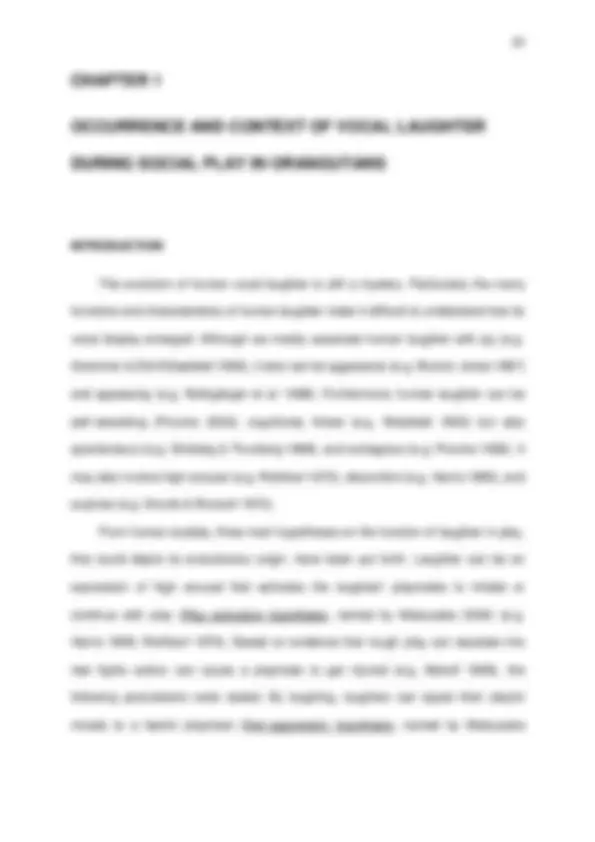







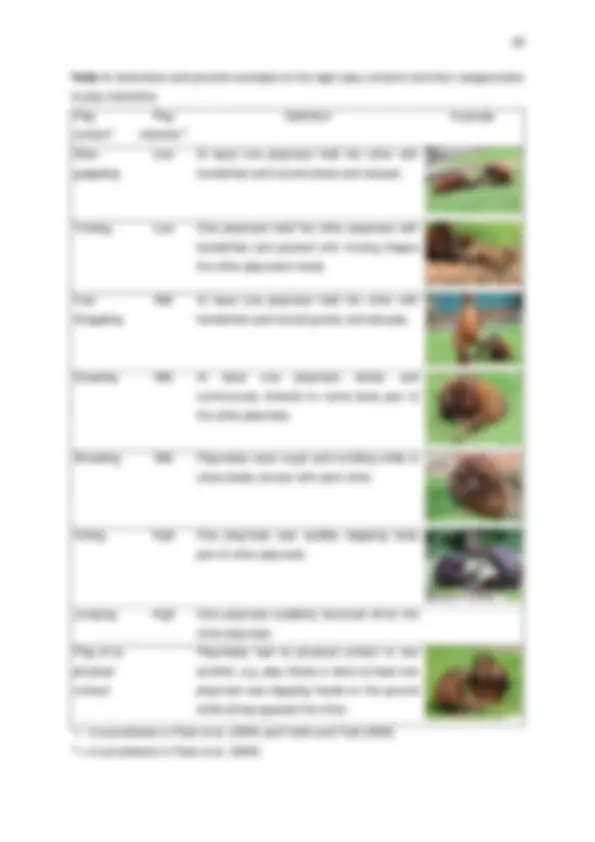
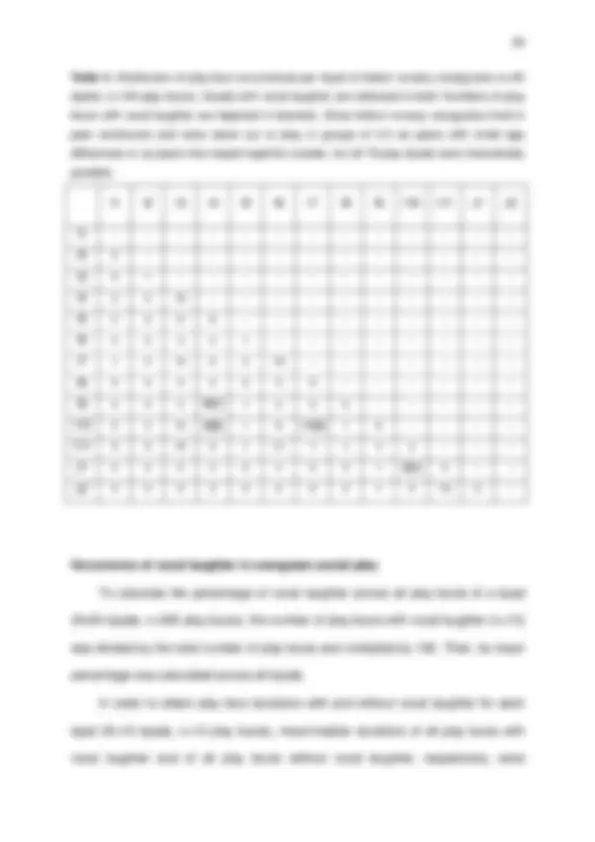
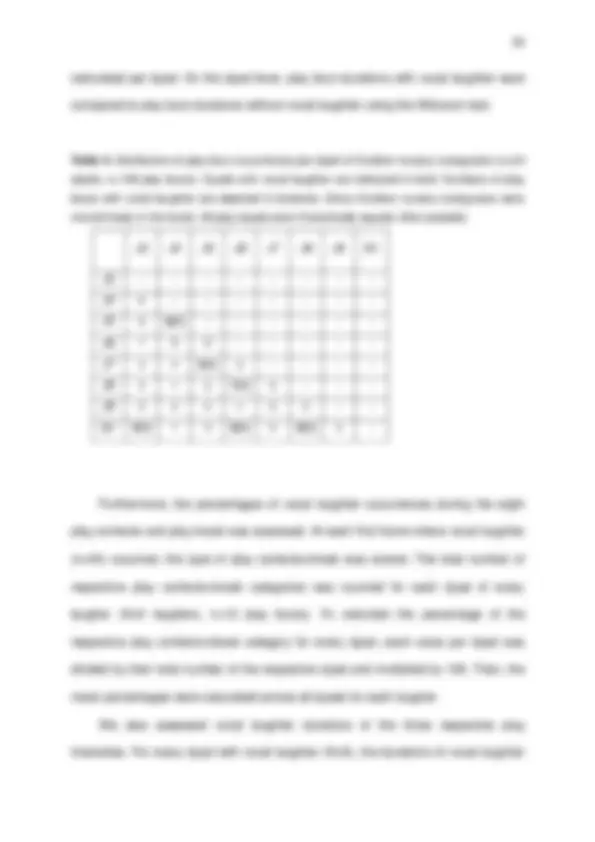
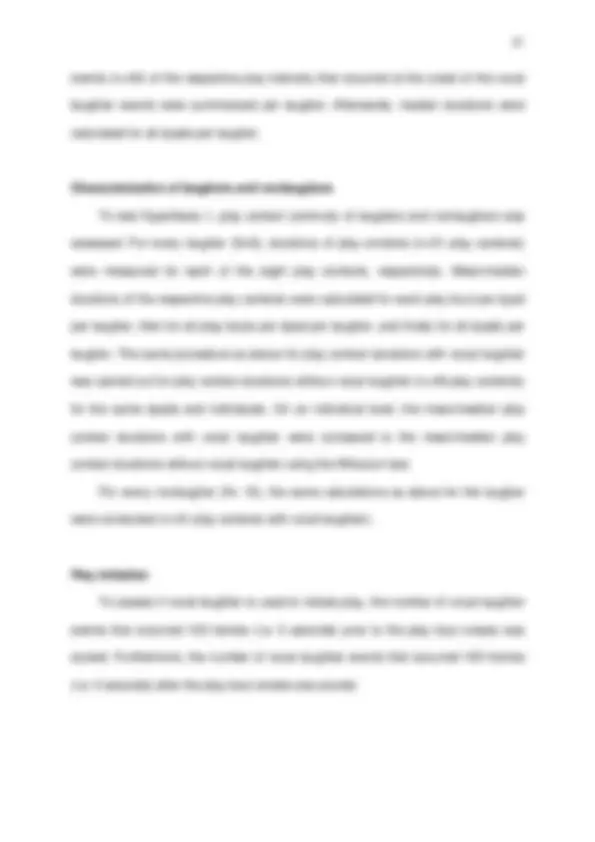
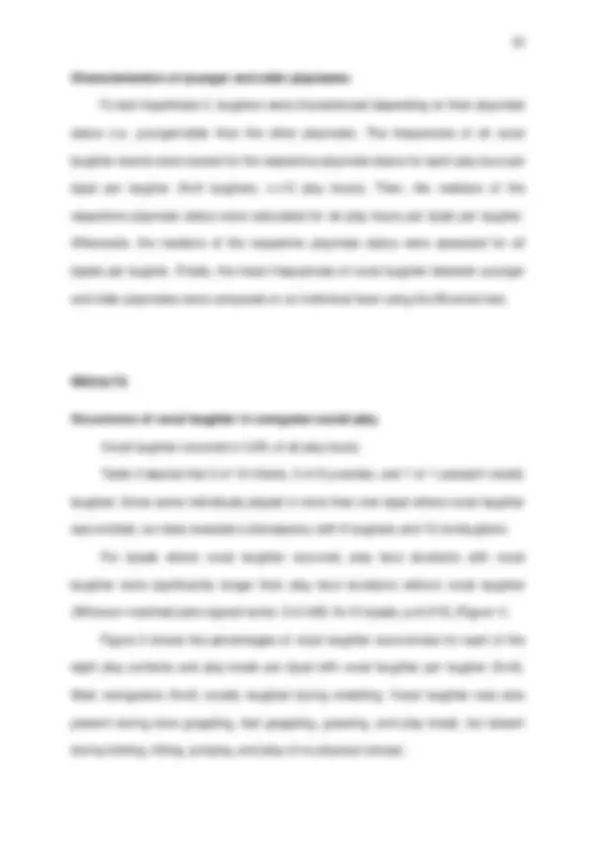



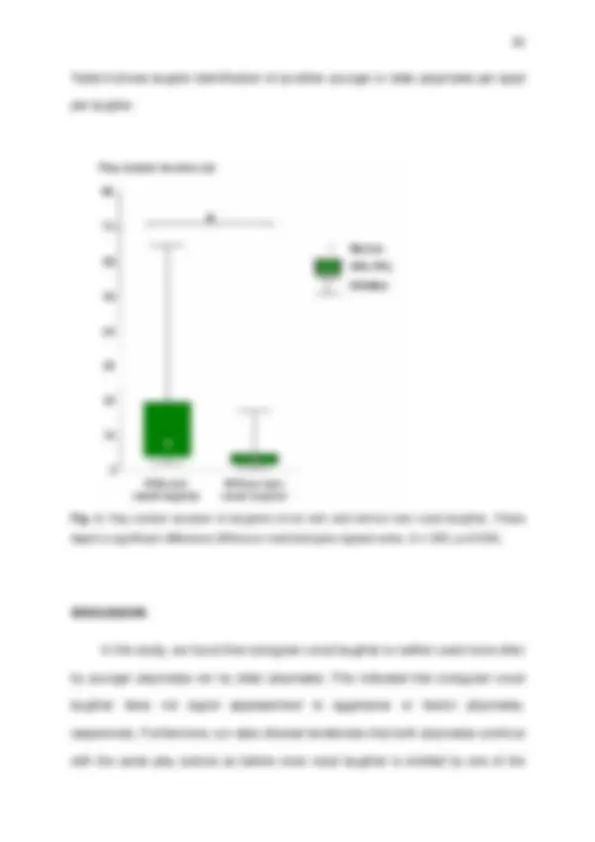
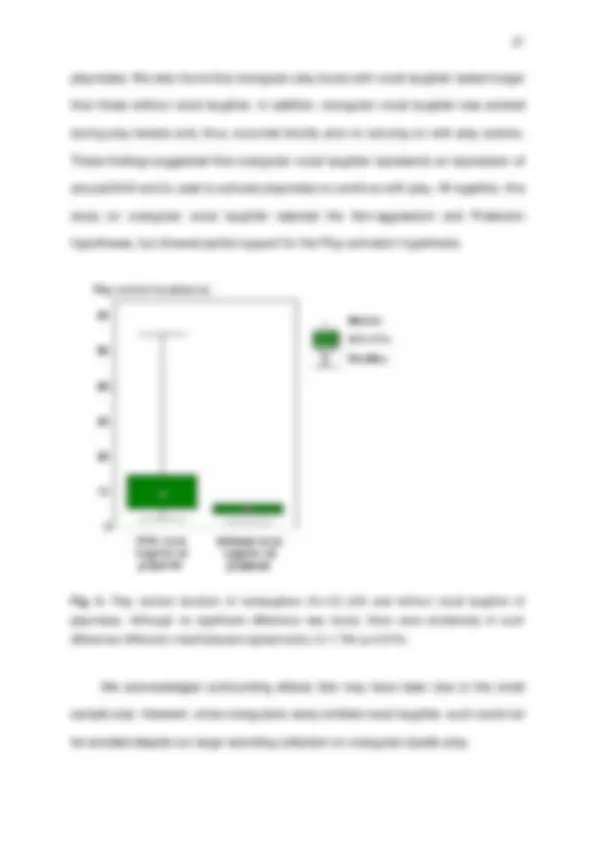
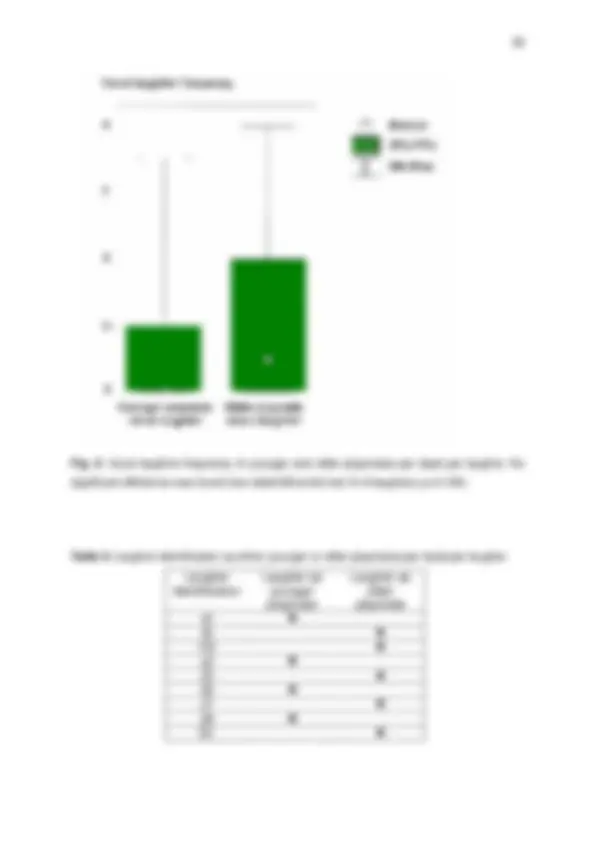


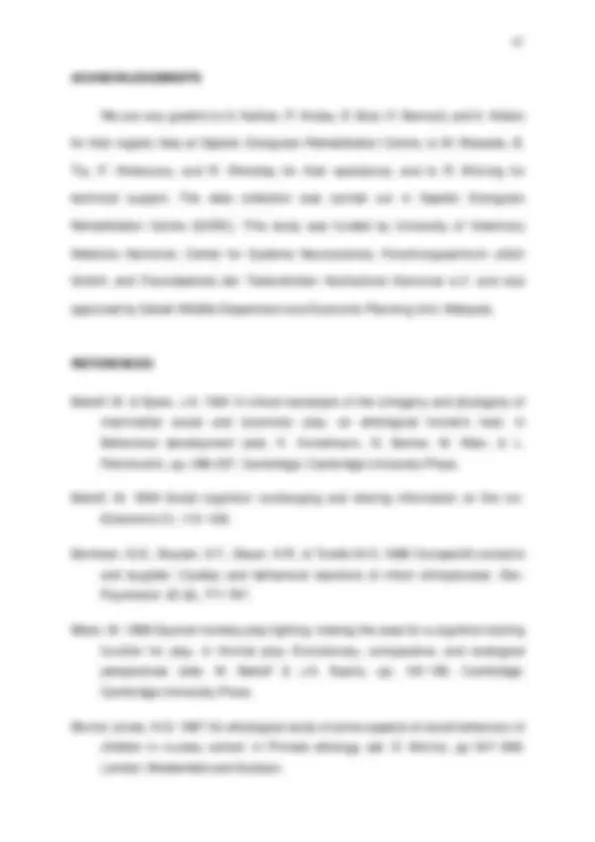


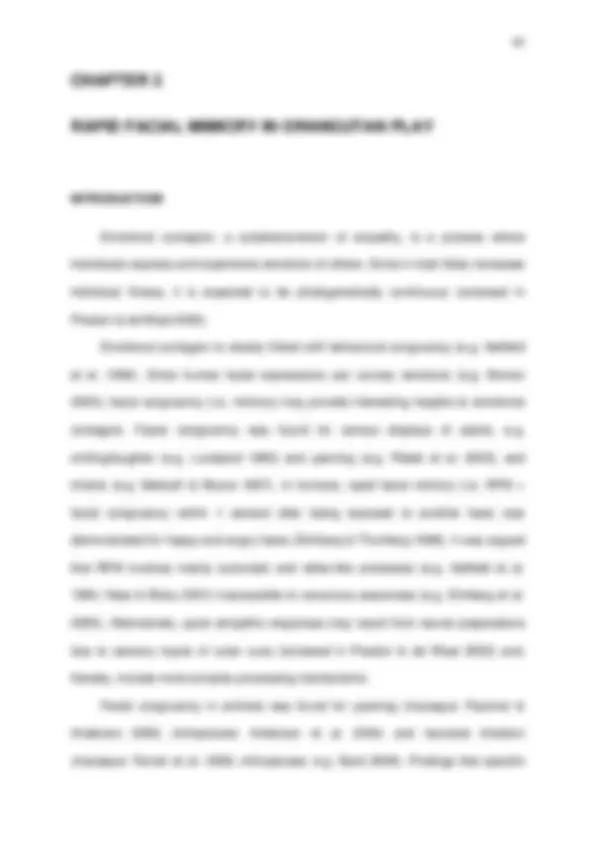
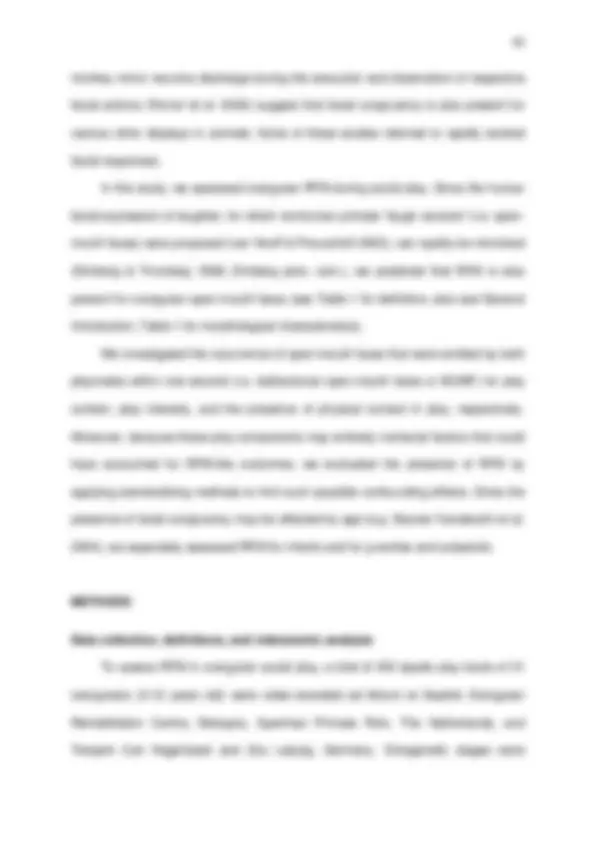




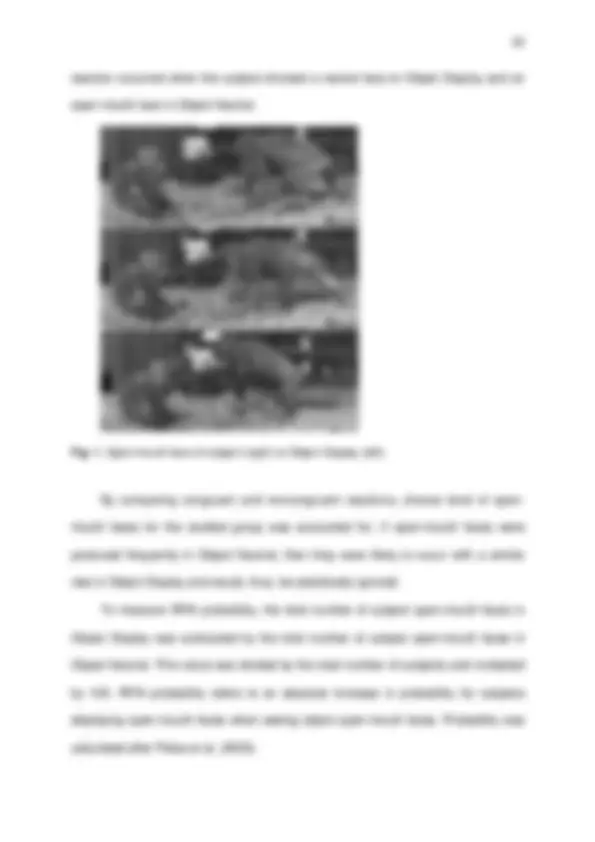

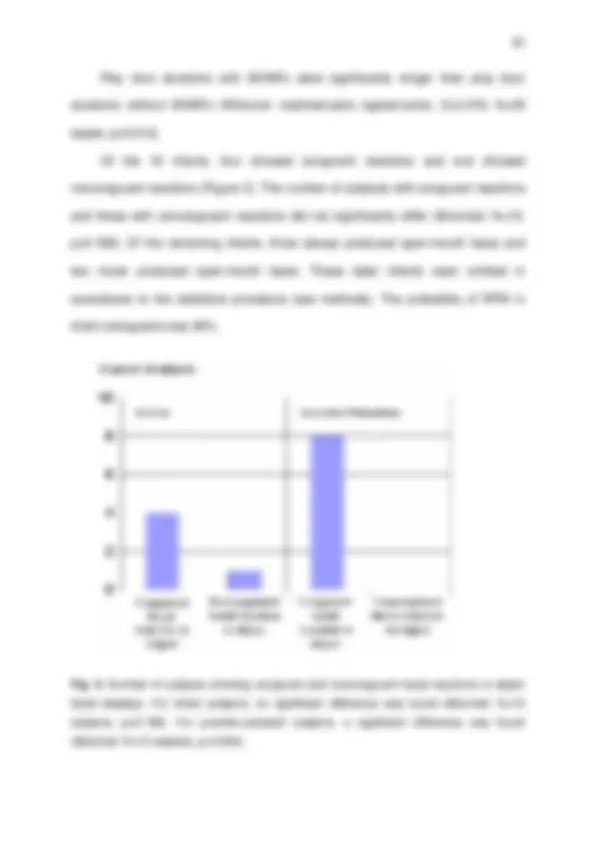
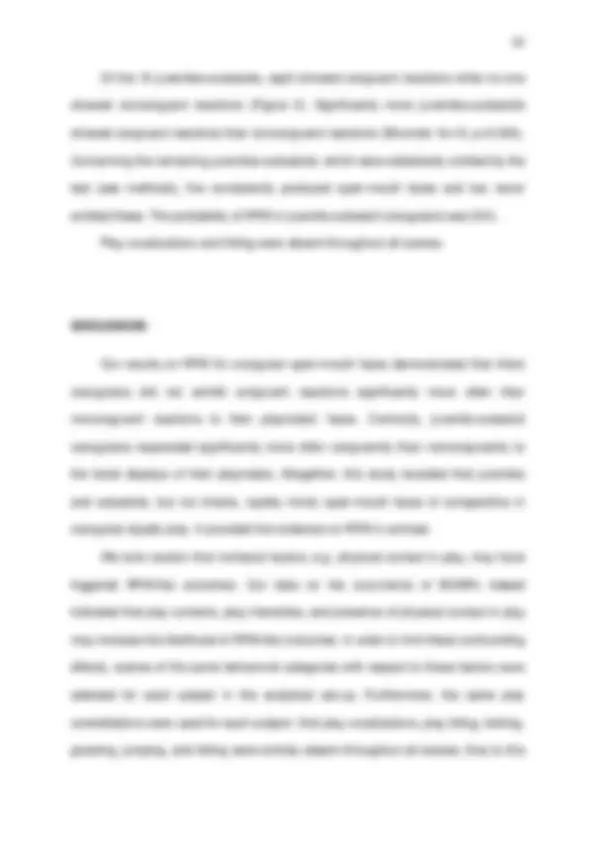

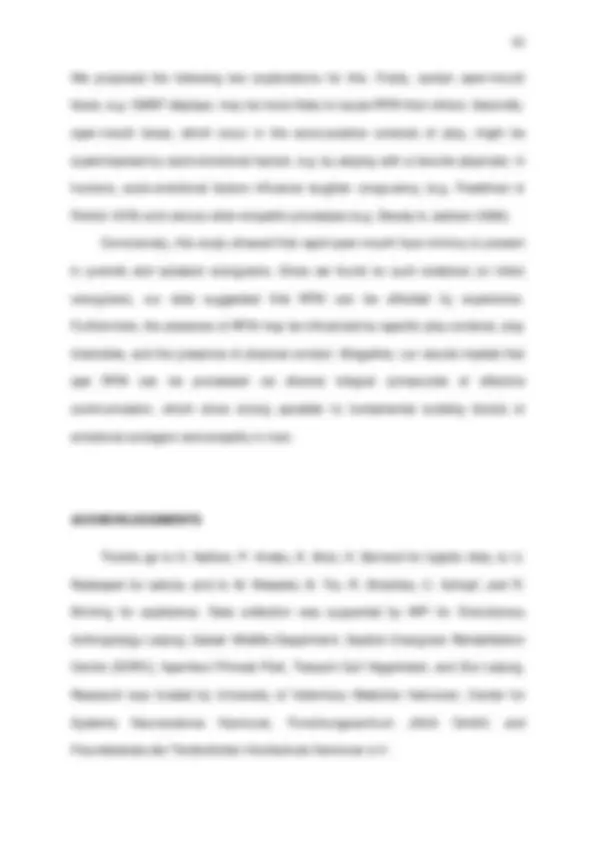



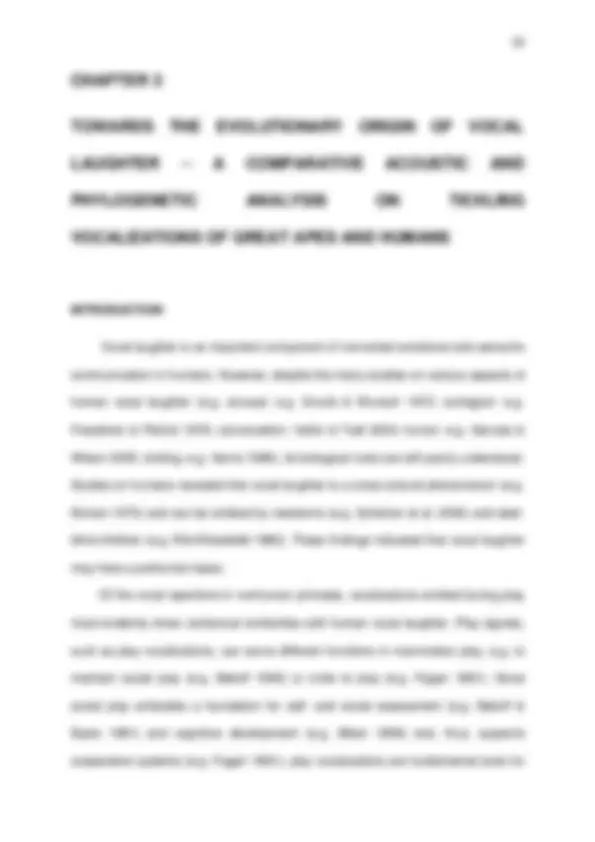


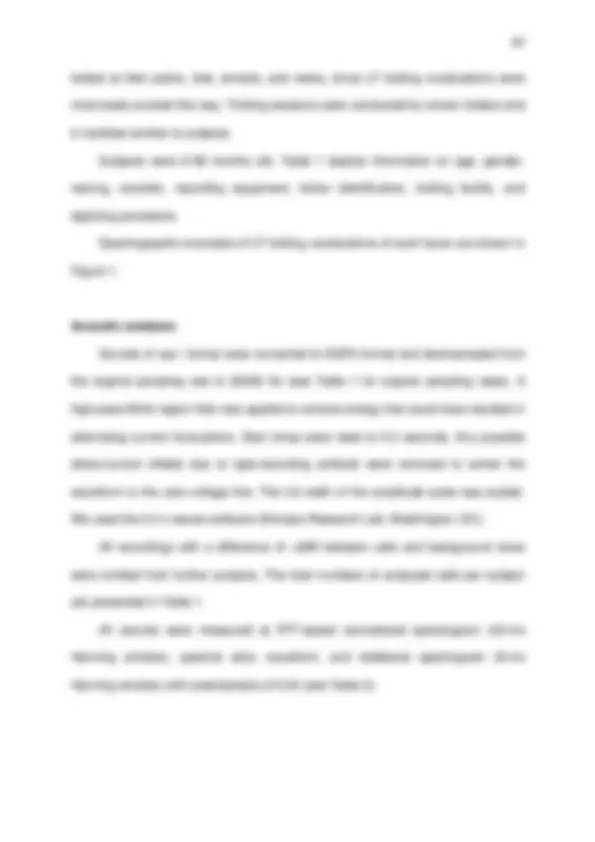

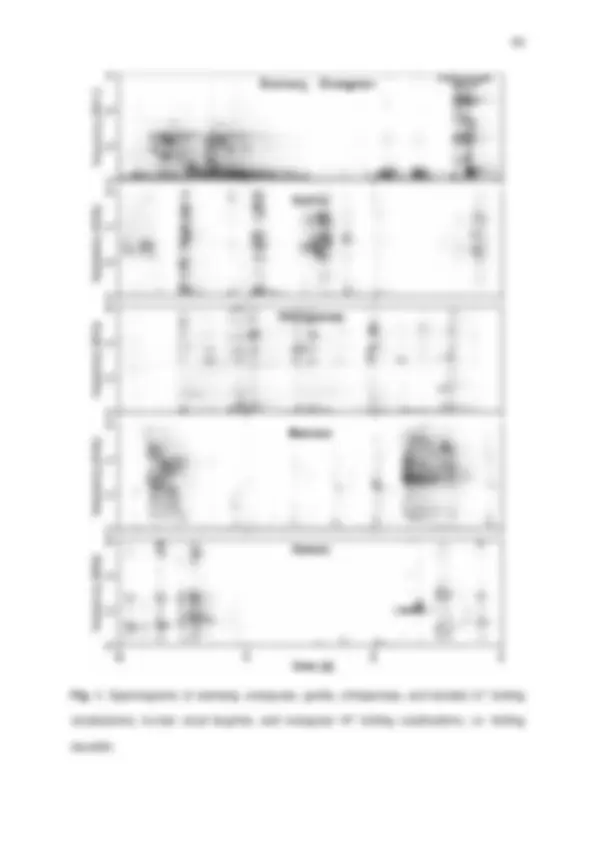



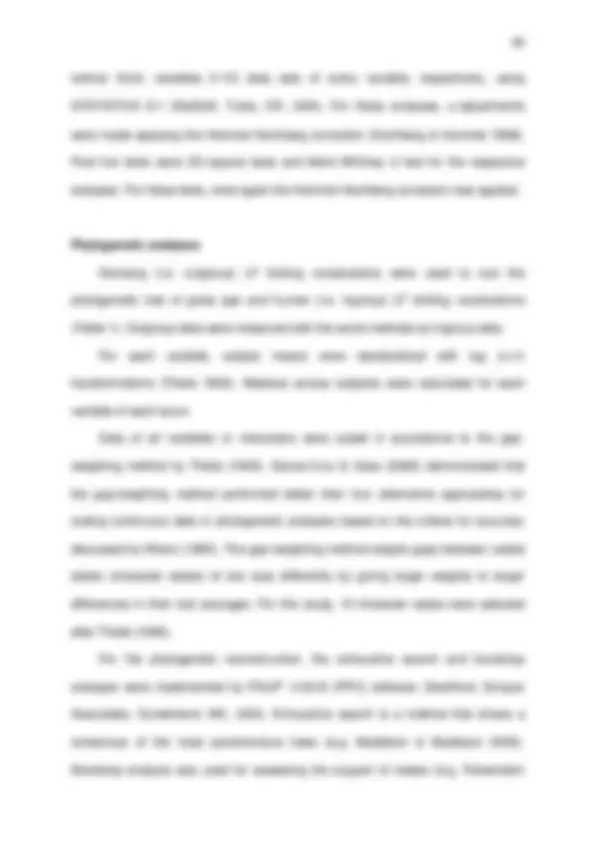
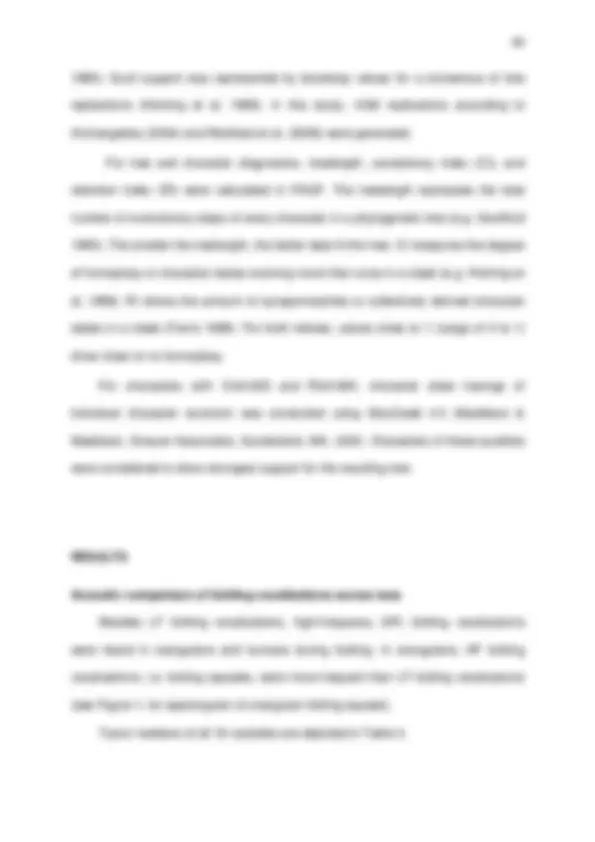

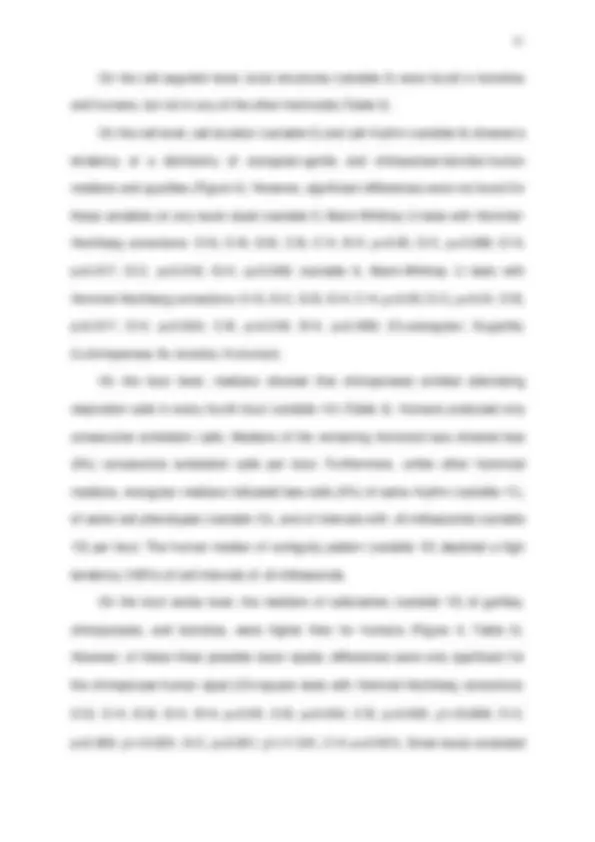
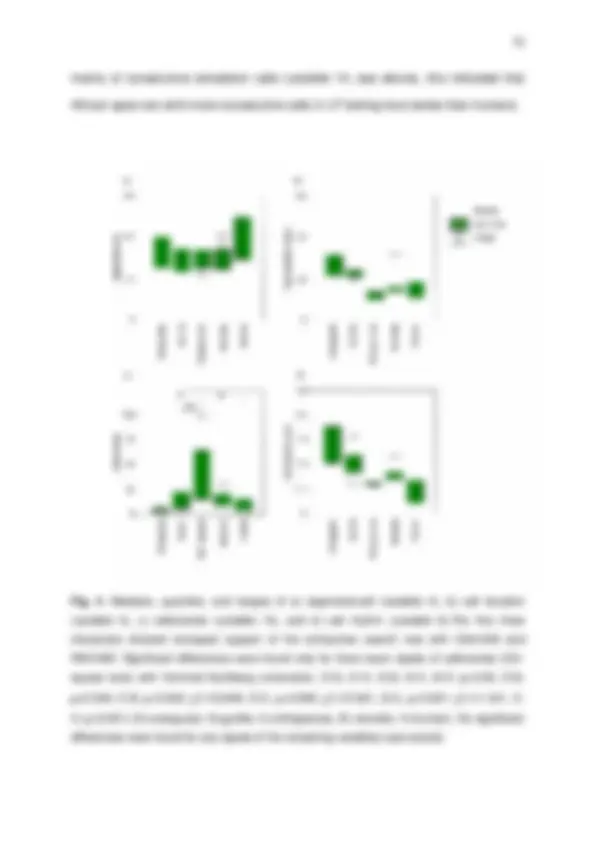
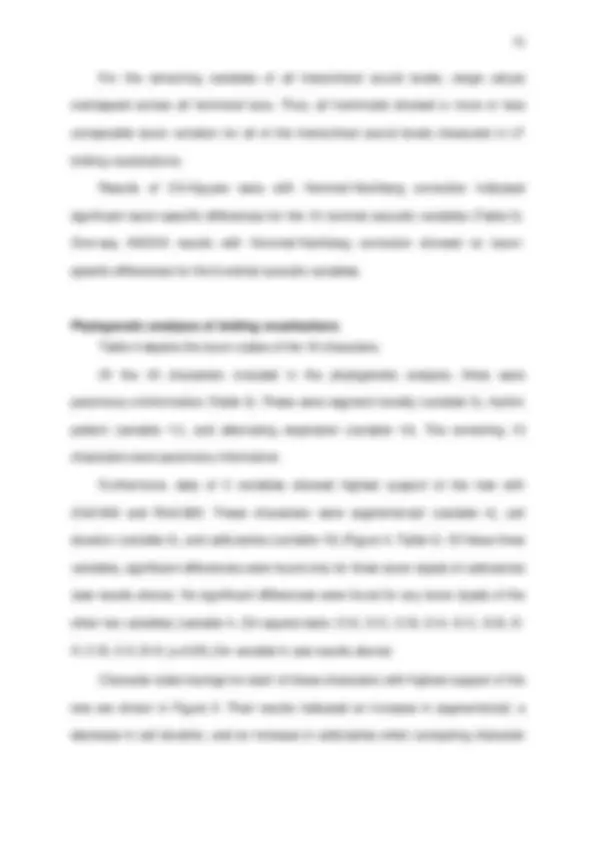
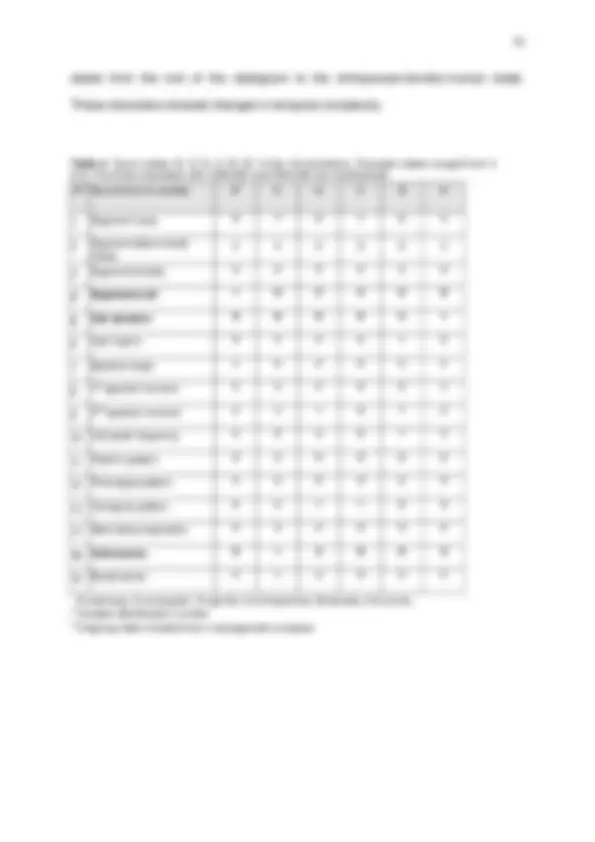
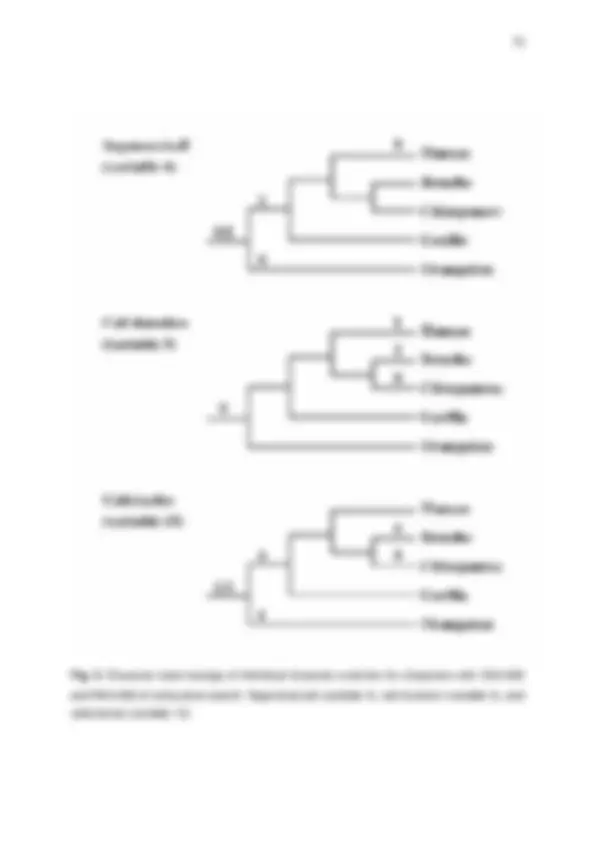
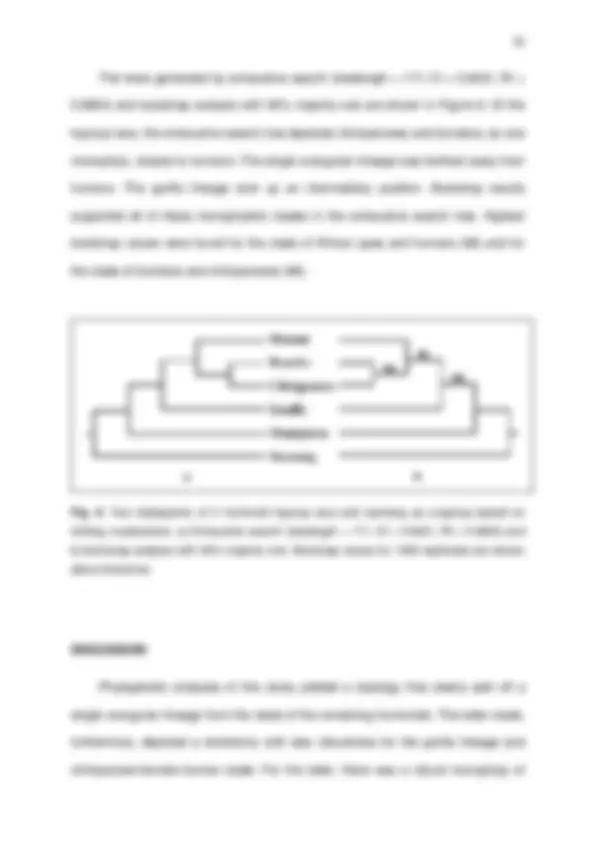




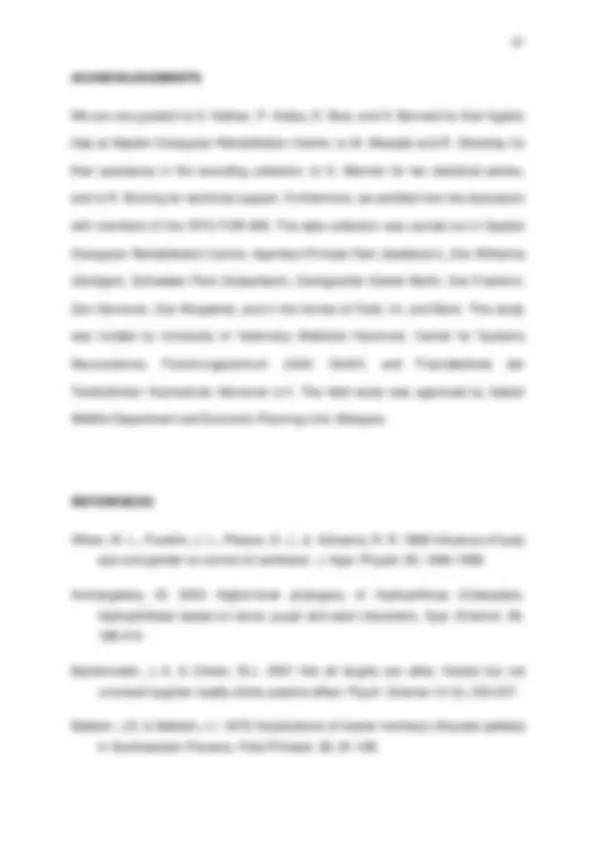




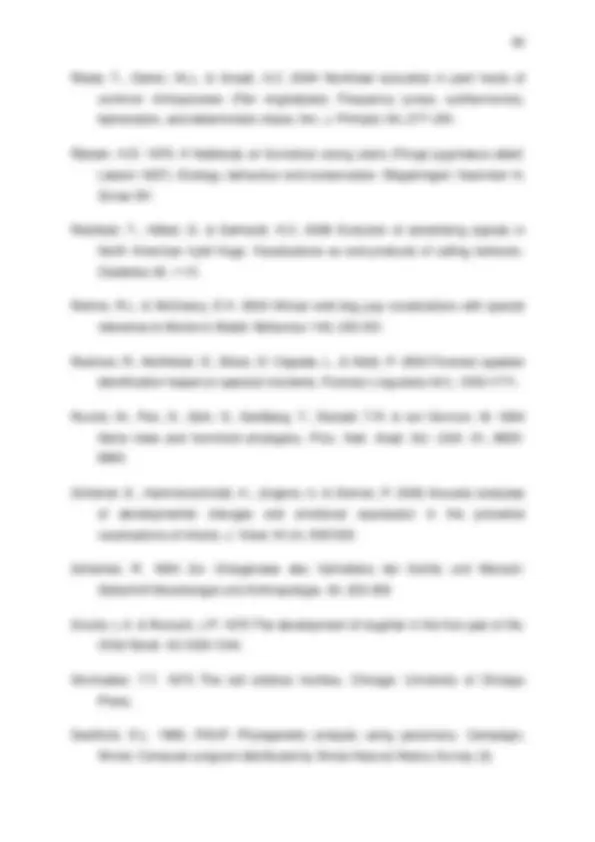



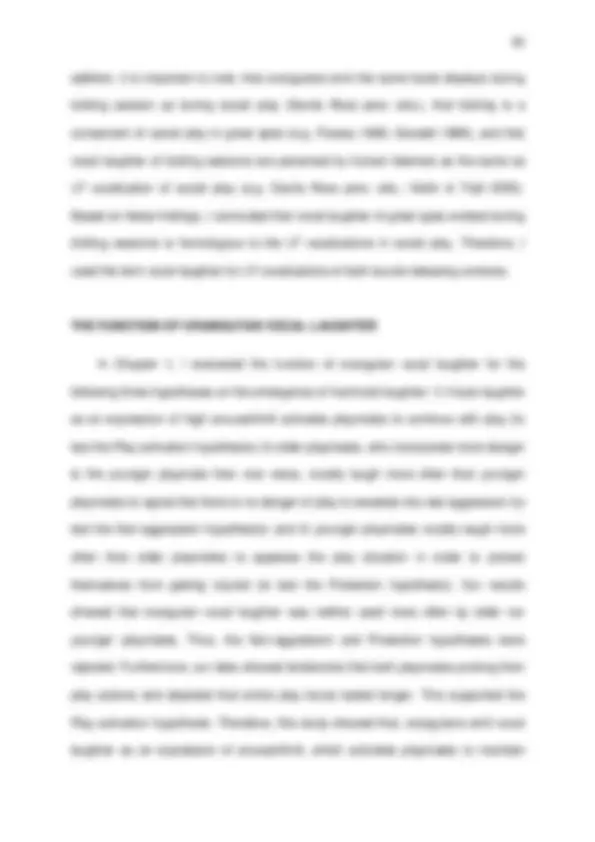



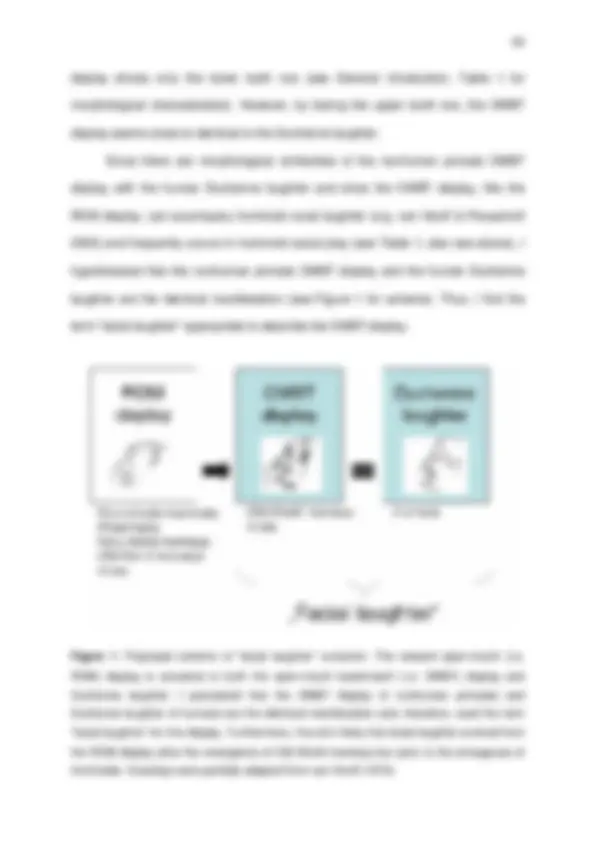


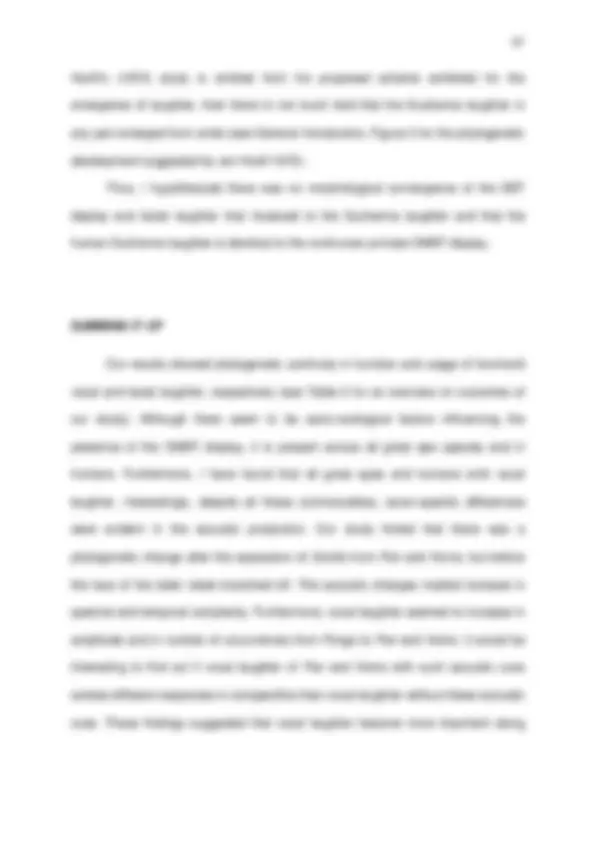




Study with the several resources on Docsity

Earn points by helping other students or get them with a premium plan


Prepare for your exams
Study with the several resources on Docsity

Earn points to download
Earn points by helping other students or get them with a premium plan
Community
Ask the community for help and clear up your study doubts
Discover the best universities in your country according to Docsity users
Free resources
Download our free guides on studying techniques, anxiety management strategies, and thesis advice from Docsity tutors
This dissertation by Marina Davila Ross from 2007 explores the occurrence and context of vocal laughter during social play in orangutans, as well as rapid facial mimicry in orangutan play. The study is supervised by Prof. Dr. Elke Zimmermann and co-supervised by Prof. Ekhardt Altenmüller and Prof. Reinhard Dengler. a comparative acoustic analysis of great apes and human laughter, and discusses the evolutionary origin of vocal laughter.
What you will learn
Typology: Summaries
1 / 114

This page cannot be seen from the preview
Don't miss anything!





























































































Page ABSTRACT 2 ZUSAMMENFASSUNG 3 GENERAL INTRODUCTION 5 CHAPTER 1: OCCURRENCE AND CONTEXT OF VOCAL LAUGHTER DURING SOCIAL PLAY IN ORANGUTANS IntroductionMethods ResultsDiscussion AcknowledgementsReferences
(^2024) (^3236) (^4141)
CHAPTER 2: RAPID FACIAL MIMICRY IN ORANGUTAN PLAY IntroductionMethods ResultsDiscussion AcknowledgementsReferences
(^4445) (^5153) (^5556)
CHAPTER 3: TOWARDS THE EVOLUTIONARY ORIGIN OF VOCAL LAUGHTER --- A COMPARATIVE ACOUSTIC AND PHYLOGENETIC ANALYSIS ON TICKLING VOCALIZATIONS OF GREAT APES AND HUMANS IntroductionMethods ResultsDiscussion AcknowledgementsReferences
(^5961) (^6976) (^8181)
GENERAL DISCUSSION 89 GENERAL ACKNOWLEDGEMENTS 99 GENERAL REFERENCES 101
ZUSAMMENFASSUNG
Eine zentrale Frage der Evolutionsbiologie ist, wie weit sich die Strategien der Kodierung und Dekodierung von affektiver Kommunikation bei Menschen und Großen Menschenaffen entsprechen. Das menschliche Lachen ist für solche Vergleiche von besonderem Interesse, da es in allen Kulturen und früh in der Ontogenie auftritt. Sein Gesichtsausdruck weist viele Gemeinsamkeiten mit dem relaxed open-mouth (ROM) display und dem open-mouth bared-teeth (OMBT) display von nichtmenschlichen Primaten auf, welche auch als “laugh variants” bezeichnet werden. Im Kontext des Kitzelns und sozialen Spiels können diese Gesichtsausdrücke bei Großen Menschenaffen, genauso wie beim Menschen, von low-frequency (LF) vocalizations begleitet sein. Im Rahmen dieser These wurde eine vergleichende videographische und bioakustische Analyse von Gesichtsausdrücken und Vokalisationen von Hominoiden (Orang-Utans, Gorillas, Schimpansen, Bonobos und Menschen) beim Kitzeln und beim Spiel durchgeführt, um Fragen ihrer Funktion, Ansteckung und Evolution zu untersuchen. In der ersten Studie haben wir die Bedeutung von LF vocalizations im sozialen Spiel bei Orang-Utans erfasst und mit denen bisheriger Studien über Menschen und Schimpansen verglichen. Unsere Resultate wiesen darauf hin, dass LF vocalizations im Spiel die Spielpartner zum weiterspielen anregen und legten damit nahe, dass die Funktion dieser Vokalisationen bei den Homonoiden phylogenetisch kontinuierlich verläuft. In der zweiten Studie analysierten wir, ob das open-mouth face (u.a. ROM display und OMBT display) des Orang-Utans beim Spiel mit Artgenossen einen kongruenten Gesichtsausdruck hervorruft und dadurch ansteckend wirkt. Die Ergebnisse der Studie zeigten, dass Orang-Utans, ähnlich wie Menschen beim Lachen, das open–mouth face des Gegenübers imitieren. In der dritten Studie untersuchten wir mittels spezieller bioakustischer und phylogenetischer Verfahren die akustischen Eigenschaften und die Phylogenie von LF vocalizations bei Großen Menschenaffen und Menschen, die durch Kitzeln hervorgerufen werden. Der Stammbaum, der aufgrund der akustischen Eigenschaften von LF vocalizations erstellt wurde, weist dabei dieselbe Topologie auf, wie der aufgrund von genetischen Markern aufgestellte. Diese Studie belegt damit erstmals, daß nicht nur Menschen, sondern auch Große Menschenaffen, beim Kitzeln lachen können und daß das
Lachen des Menschen deshalb auf evolutionäre Wurzeln zurückzuführen ist, die mindestens 12-16 Millionen Jahre alt sind.
contagion, facial morphology and bioacoustics, socio-ecology, and evolution by assessing humans and our closest relatives, the great apes.
THE FUNCTION OF HUMAN LAUGHTER
The diversity of contexts in which human laughter appears makes it difficult to trace its functions. The most parsimonious and probably most informative approach to elucidate human laughter function is by studying the usage of children laughter and nonhuman primate play signals during social play or during tickling sessions. The following three hypotheses were proposed. Laughter may function to activate others to continue with play (Rothbart 1973) (Play activation hypothesis, named by Matsusaka 2004). Furthermore, it is argued that rough play can quickly loose its playful side and escalate to real fights or other aversive behaviors (e.g. Bekoff 1999). To avoid such change in behaviors, playmates may signal a playful mood to playmates on the verge of becoming either fearful or angry (e.g. Caron 2002). This way, laughter of play could either be used to prevent an escalation in play by indicating a playful mood (Non-aggression hypothesis, named by Matsusaka 2004) or to protect oneself from getting injured by an angry playmate (Protection hypothesis, named in this study).
HUMAN LAUGHTER CONTAGION
One of the factors that add to the phenomenology of human laughter is its contagion. For the vocal (e.g. Smoski & Bachorowski 2003) and facial (e.g. Lundqvist
humans most frequently congruent behaviors in every-day situations. Simply by mimicking happy faces, humans can perceive positive emotions (Lundqvist 1995). Thus, by means of display congruency, people may experience and understand the same emotions of others, a process that is termed emotional contagion (Hatfield et al. 1994). Emotional contagion most likely embodies an integral component of our social behavior.
FACIAL MORPHOLOGY OF HUMAN LAUGHTER
Zygomatic major (mouth corners back+up) and orbicularis oculi (eye wrinkles) are fundamental muscles that cause the typical facial manifestation of humans while laughing (reviewed in Ruch & Ekman 2001). Additionally, masseter and pterygoids are used for lowering the jaw. Gervais and Wilson (2005) distinguished between two displays of human laughter, namely Duchenne laughter and non-Duchenne laughter (see Figure 1). They argued that while the Duchenne laughter is driven by a stimulus and is an affective manifestation, the non-Duchenne laughter is self-generated and has no emotional meaning.
Fig. 1. Examples of facial expressions of an adult human while laughing. a) Duchenne laughter: driven by a stimulus and expressed in a positive emotional context of high arousal and b) non-Duchenne laughter: self-generated and emitted in context of no affective meaning.
where the lower tooth row is bared (see Table 1 for morphological characteristics of ROM).
Fig. 2. ROM displays of two chimpanzees (9 and 10 years of age) during dyadic play.
Table 1. Overview of morphological characteristics and presence of staccato breathing (low- frequency play vocalization) for ROM display and OMBT display in accordance to Preuschoft (1995).
Relaxed open-mouth display (i.e. ROM display)
Open-mouth bared- teeth display (i.e. OMBT display) Lips Loose or slightly retracted Retracted Teeth Lower row bared, upper row covered Bared Mouth Moderately to widelyopen Wide open Staccato breathing Present Present
Decades later, van Hooff and Preuschoft (2003) revised this view on laughter evolution by stating that nonhuman primates produce “laugh variants”, which are open-mouth expressions ranging in the degree of baring the teeth. These authors argued that, in addition to the ROM display, an open-mouth display of showing no teeth and the relaxed open-mouth bared-teeth (i.e. OMBT) display belong to the category of “laugh variants” (i.e. open-mouth faces, in this study) (see Table 1 for morphological characteristics of OMBT). Similar to the ROM display, the OMBT display is produced in nonhuman primates during play (e.g. Preuschoft 1995) and can be accompanied by “panting laugh” (i.e. low-frequency play vocalizations) in great apes (e.g. de Waal 1988). In their review, van Hooff and Preuschoft (2003) argued that the ROM display and OMBT display are both emitted by Old World monkeys, but that the former is more frequently produced by species phylogenetically more distanced to man, e.g. New World monkeys, prosimians, and canids, than the latter. This implies that the ROM display is ancestral to the OMBT display. Thus far, little is known about the occurrence of these two facial displays in great apes other than chimpanzees and bonobos. While the ROM display is more common in chimpanzees (e.g. Waller & Dunbar 2005), bonobos exhibit more frequently the full play face (i.e. OMBT display) (e.g. Palagi 2006). However, some chimpanzees may produce full play faces (i.e. OMBT displays) as frequently as they produce play faces (i.e. ROM displays) (Palagi 2006). Thus, these two displays may occur side by side within a species. They may also have different functions (e.g. Palagi 2006). Besides occurring in the socio-positive context of play, the chimpanzee ROM display can be perceived by conspecifics as a positive state (Parr 2001), may reflect motivation to play (Waller & Dunbar 2005), and serve social bonding (Waller &
terms LF tickling vocalization and LF play vocalization, respectively, to describe these vocalizations (see Chapter 3, Figure 1 for spectrograms). Great ape staccato breathing (i.e. LF tickling/play vocalization) often accompanies ROM and OMBT displays (e.g. Chevalier-Skolnikoff 1982; Preuschoft 1995).
Fig. 3. Phylogenetic modifications of “smile” and “laughter” of macaques ( Macaca spp.), chimpanzees ( Pan spp.), and humans ( Homo spp.) as suggested by van Hooff (1972). This graphic depicts smile and the SBT displays on the left side and laughter and the ROM display on the right side. The three chimpanzee SBT displays are a) horizontal SBT display, b) vertical SBT display, and c) open-mouth SBT display. In accordance to the Emancipation hypothesis, the open-mouth SBT display converged with the ROM display to ritualize as the facial expression of human laughter. Drawings were adapted from van Hooff (1972).
Thus far, only one study specifically assessed the function of great ape LF tickling/play vocalizations by testing the hypotheses on human laughter function (see above). In this study, Matsusaka (2004) showed that chimpanzees are more likely to continue with play after their playmates emitted play pantings (i.e. LF play vocalizations). This supported the Play activation hypothesis (see above). Furthermore, Matsusaka (2004) found no evidence that play pantings are used to signal “this is just play” to a playmate that may feel in danger of getting hurt and, thus, may stop playing. Consequently, Matsusaka (2004) rejected the Non- aggression hypothesis (see above). While studying chimpanzees, Vettin and Todt (2005) argued that during rougher play, like wrestling, playmates cannot have much eye contact and, therefore, might be more likely to express play vocalizations than during less intensive play. Thus far, all that is known about great ape LF tickling/play vocalizations is based on chimpanzees. These vocalizations of chimpanzees share acoustic commonalities with human vocal laughter in interval duration and intra- and interindividual variability (Vettin & Todt 2005). However, while chimpanzees produce vocalizations with alternating exhalation and inhalation sounds during play and tickling (Vettin & Todt 2005), human vocal laughter is characterized by its series of consecutive expiratory sounds (Provine 1996). Provine (1996) suggested that limitations to modulate exhalation phases in chimpanzees, may be an integral factor of their incapability to speak besides, for instance, anatomic differences in the vocal apparatus (see Lieberman 1975). To date, little is known about LF tickling/play vocalizations of great apes other than chimpanzees. Comparative studies showed that orangutans, gorillas, chimpanzees, bonobos, and humans carry a rich vocal repertoire of tonal and atonal structures and can range
respectively (reviewed in Rowe 1996). Of these two latter species, bonobos are more egalitarian (de Waal 1995, 2001). While orangutans and gorillas show a remarkable sexual dimorphism, this is less evident in Pan. Preuschoft (1995) proposed the Power asymmetry hypothesis of motivational emancipation, in which species of despotic dominance systems produce more distinct displays of submission, affiliation, and playfulness than those of a more egalitarian social system. She argued that the articulateness of a signal, which could avoid fighting, may be more important for members of the former system. Her results on macaque SBT displays, ROM displays, and OMBT displays (as SBT-ROM intermediates) were compared to these displays of chimpanzees and human smile and laughter. Because these signals may occur differently across phylogenetically close species but may be used similarly in remotely related species, these authors predicted analogies. In tune with the argumentation of Preuschoft (1995), Palagi’s (2006) study showed that the more egalitarian bonobos emit full play faces (i.e. OMBT displays) more often than the less egalitarian chimpanzees. Furthermore, it was suggested that primates with less distinct sexual dimorphism may have less pronounced gender differences in play behavior than those with more apparent sexual dimorphism (Stevenson & Poole 1982).
Human listeners perceive great ape LF vocalizations of tickling as the same as those of social play (e.g. Chevalier-Skolnikoff 1982; Davila Ross, pers. obs.; Vettin & Todt 2005). Like in humans, tickling is also a component of great ape social play (siamangs: T. Geissmann pers. comm.; orangutans: Davila Ross pers. obs.; gorillas: e.g. Fossey 1972; e.g. chimpanzees: Matsusaka 2004; e.g. bonobos: de Waal 1988).
However, thus far, it is not known if tickling and social play contexts are homologous. Since the chapters of this thesis focused on displays of tickling sessions and social play, I aimed to clarify the phylogenetic relationship between these two sound- releasing contexts as presented in Table 3.
Table 3. The relative frequency of four facial displays in orangutans (N=10) while emitting LF vocalizations (n=218) during tickling sessions (n=97) with human ticklers. Tickling sessions were conducted according to Chapter 3. Tickling sessions were video-recorded and the presence of LF tickling vocalizations and four facial displays (open-mouth face, bite face, relaxed face, and nonrelaxed face) were coded in accordance to Chapters 1 and 2, respectively. The number of vocal events was scored for each facial display per orangutan. Each number of the respective facial display was divided by their total number per individual and multiplied by 100. Thereafter, means, standard deviations, and ranges of the four facial displays, respectively, were calculated for all orangutans.
identification^ Individual Open-mouth face^ Bite face^ Relaxed face^ Nonrelaxed face (^12 5063 00 00 ) (^34 5069 2531 00 ) 56 9786 00 00 143 (^78 3277 08 00 ) 109 5559 150 00 3041 Standard^ Mean^ 63.8^ 7.9^0 28. deviation Range 32-9719.1^ 11.80-31^ 0-0^0 0-6821.
Table 3 shows the relative frequency of four facial displays of orangutans (open-mouth face, bite face, nonrelaxed face, and relaxed face) while emitting LF vocalizations during tickling sessions with human ticklers. These facial displays were selected as they appear in orangutan social play (Davila Ross pers. obs.; also see Chapter 2, Table 1 for definitions).
vocalizations and human laughter in their function (Chapter 1), contagion (Chapter 2), and evolution (Chapter 3).
Chapter 1 Since our knowledge on the function of great ape LF play vocalizations is solely limited to chimpanzees (e.g. Matsusaka 2004), I assessed LF vocalizations of orangutan play in order to shed light on this topic while leaning on the three hypotheses on human laughter. 1) Play activation hypothesis: Orangutan LF play vocalizations activate playmates to continue with play (Rothbart 1973). 2) Non- aggression hypothesis: Orangutan LF play vocalizations indicate a playful mood and prevent playmates from discontinuing play out of fear from getting hurt (Caron 2002).
Chapter 2 Preston and de Waal (2002) postulated phylogenetic continuity of empathic components between animals and humans as they facilitate social species by forming and keeping social bonds. Although display congruency is an integral component that adds to the phenomenology of human laughter, thus far, it was not assessed if it is present for the proposed homologous nonhuman primate modes of the human Duchenne laughter. Based on the commonalities between nonhuman primate open-mouth faces (e.g. ROM and OMBT displays) and the human Duchenne laughter (see above), I hypothesized that open-mouth faces can trigger facial
congruency in orangutans during social play. In this study, I specifically assessed rapid (within 1 second) facial responses.
Chapter 3 Since human laughter is a cross-cultural phenomenon (e.g. Ekman 1973) and is emitted by infants from the age of four months onwards (e.g. Scheiner et al. 2002), newborns with gelastic epilepsy (Ruch & Ekman 2001), and deaf-blind children (e.g. Eibl-Eibesfeldt 1985), I postulated that human vocal laughter has a prehuman basis. Because of the many commonalities between great ape LF tickling/play vocalizations and human vocal laughter (see above), I phylogenetically analyzed LF tickling vocalizations of orangutans, gorillas, chimpanzees, and bonobos and human vocal laughter. Hereby, I predicted that these vocalizations share the same phylogenetic root. A resulting tree of these vocalizations that coincides with the widely accepted systematic topology of hominoids based on genetic studies (e.g. McBrearty & Jablongski 2005; Ruvolo et al. 1994; Wildman et al. 2002) (Figure 5), would confirm such homology.
Fig. 5. Systematics of great apes and humans based on genetic studies (e.g. McBrearty & Jablongski 2005; Ruvolo et al. 1994; Wildman et al. 2002).